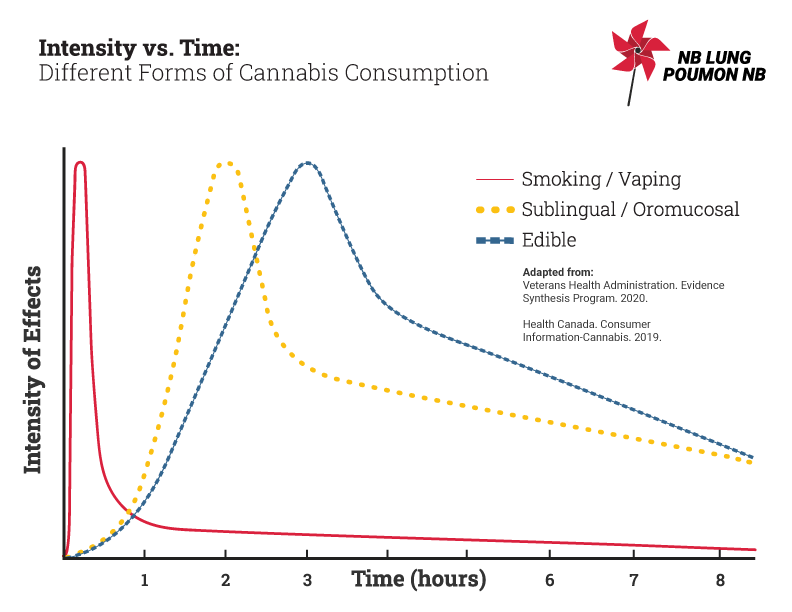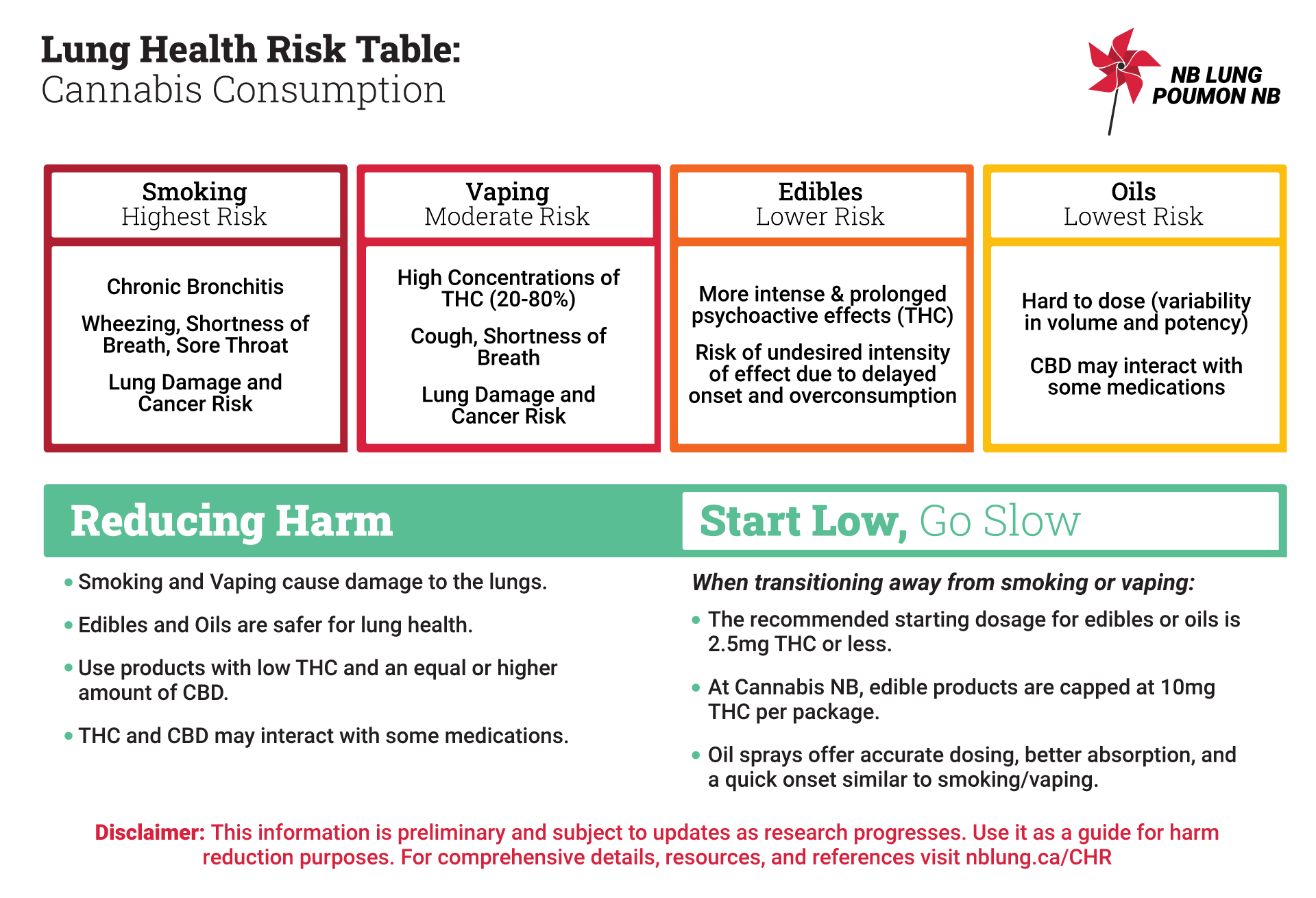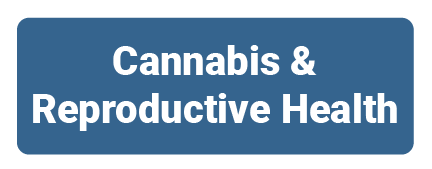It’s time to talk about:
Cannabis
Did You Know?
Smoking remains the most prevalent and risky method of cannabis consumption.
Smoking cannabis, no matter how it’s done, exposes the lungs to harmful toxins and carcinogens, similar to those found in tobacco smoke. These substances can cause lung irritation, chronic bronchitis, and may increase the risk of respiratory infections or more serious health issues over time.
For those who use cannabis, exploring less harmful methods of consumption—such as edibles or oils — can significantly reduce risks to lung health.
Smoking is the most common way that people use cannabis, and one of the most harmful.
Embracing a Cannabis Harm Reduction approach is key to minimizing potential harm while making informed decisions about use, supporting healthier respiratory outcomes.
Understanding Cannabis Effects: A Simple Guide the Project
The graph below shows how different ways of using cannabis affect you over time. It helps you see:
- How quickly you feel the effects: Different methods (smoking, eating, or using cannabis oil under your tongue) start working at different speeds.
- How strong the effects are: The graph shows the peak intensity, which is how strong the effects get at their highest point.
- How long the effects last: You can see how long each method keeps affecting you.
Cannabis: Know the Risks
Smoking
- Toxic Smoke: Smoke from burning cannabis contains harmful substances similar to those found in tobacco smoke.
- Deep Inhalation: Cannabis smokers tend to breathe in deeply and hold their breath longer than cigarette smokers, leading to increased tar exposure.
- Respiratory Issues: People who smoke cannabis frequently, without mixing it with tobacco, often have more visits to healthcare providers for respiratory problems compared to non-smokers.
Vaping
- Weakened Immune System: Vaping cannabis can make the immune system weaker and increase the risk of lung infections.
- Perceived Safety: Some people believe vaping is safer for the lungs than smoking, which might lead to more frequent use or starting cannabis use earlier, increasing the risk of problematic use or addiction.
Edibles
- Accidental Ingestion: There is a risk of children accidentally eating cannabis edibles, which can be dangerous.
- More intense effects: Longer and more intense psychoactive effects (THC)
- Delayed onset: Edibles take a while to kick in, which can make people eat too much before they feel anything.
Oils
- Drug Interactions: Since both THC and CBD are processed by the liver, there’s a chance they could interact with other medications, affecting how they work in the body.
- Hard to dose: Oils can be hard to dose (volume and potency vary a lot).
Switching to Safer Cannabis Use: What You Need to Know
Knowing how long it takes for different ways of using cannabis to start working and how long the effects last can help people move from smoking to safer methods. Here’s why it matters:
- Quick Relief: Many people smoke cannabis because it works fast, helping with pain, getting high, or feeling its effects quickly.
- Awareness of Alternatives: Some might not know about other ways to use cannabis that are safer for their health.
- Oil sprays offer more accurate dosing, better absorption, and a quick onset similar to smoking/vaping.
- Edibles have a delayed onset, but the effects can last longer and be more intense. Understanding this information can help people find safer options that still meet their needs.
Transitioning Away From Smoking: Edibles and Oils
- Switching to edibles and oils can be better for your lungs.
- Choose Low THC and Higher CBD: Products with low THC and an equal or higher amount of CBD are recommended.
- Benefits of CBD: CBD can reduce the side effects of THC, especially useful during the day or when driving.
- Medication Interactions: THC and CBD can interact with some medications.
- Example 1: CBD can affect how clobazam, a medication for seizures, is processed.
- Example 2: Cannabis can also affect warfarin, a blood thinner, making it work more strongly.
- Medical vs. Recreational Use: Medical cannabis patients often use products with more CBD and less THC to improve symptoms, function, and quality of life, with fewer side effects.
Protecting Your Lungs: A Simple Guide to Cannabis Use
This table shows how different ways of using cannabis affect your lungs, from safest to most risky. It’s a helpful tool to:
- Rank the risks: It lets you see which methods are better or worse for your lung health.
- Highlight dangers: It points out that smoking and vaping are the riskiest for your lungs.
- Suggest safer options: It encourages you to consider safer alternatives like edibles or oils to keep your lungs healthy.
This guide helps you make informed choices about how to use cannabis while taking care of your lung health.
Start Low, Go Slow
When starting with cannabis, it’s best to “start low, go slow, and stay low.”
- Consider safer alternatives like edibles and oils and be aware of how cannabis might interact with other medications.
- Edibles: Start with 2.5 mg of THC or less.
- Choose Low THC and Higher CBD: Products with low THC and equal or higher CBD are recommended.
- Sublingual Sprays: These offer precise dosing, better absorption, and a quick effect similar to smoking or vaping.
- Be Aware of Drug Interactions: Learn how cannabis may interact with other medications you are taking.
Cannabis and Impaired Driving
Using marijuana before driving can significantly increase the chances of getting into a car accident.
People who have used cannabis are up to six times more likely to crash than those who haven’t used it.
While many people think that driving under the influence of cannabis is risk-free, and that drivers on cannabis are more cautious and drive slower, research tells us that cannabis can indeed impair driving abilities, causing issues like reduced focus, slower reaction times, drifting in lanes, and a distorted sense of time and distance.
Regular cannabis users might not realize how impaired they are when they’re driving.
Other Considerations: Cannabis & Reproductive Health
Using cannabis during pregnancy can harm reproductive systems and early childhood development. Due to limited research, it’s best to be cautious with cannabis use during pregnancy to avoid risks to the baby.
Know the Reproductive Risks
Cannabis & Pregnancy
- Using cannabis during pregnancy can harm female reproductive systems and early childhood development. Due to limited research, it’s best to be cautious with cannabis use during pregnancy to avoid risks to the baby.
- Cannabis can affect hormones and reproduction, potentially disrupting menstrual cycles and ovulation.
- THC can remain in the body for up to 30 days after stopping use.
- Many pregnancies are unplanned, so women may unknowingly use cannabis early in pregnancy.
- THC crosses the placenta and can decrease fetal folic acid, essential for development, leading to risks like miscarriages and low birth weight.
- Cannabis use during pregnancy can impair a child’s memory, learning, and other cognitive functions.
- Passive exposure to cannabis smoke can also affect pregnant women and their babies.
Cannabis and Breastfeeding
- THC can remain in breast milk for weeks and be more concentrated than in the mother’s blood.
- Babies exposed to THC through breast milk may experience drowsiness, reduced muscle tone, and poor feeding, impacting their nutrition.
Cannabis and Male Infertility
- Cannabis use can lead to poor sperm quality, lower sperm count, and higher rates of erectile dysfunction.
- THC can interfere with important reproductive processes like sperm maturation.
NB Lung has been helping New Brunswickers breathe easier since 1933.
Thank you for your support!
Page Last Updated: 28/02/2023






